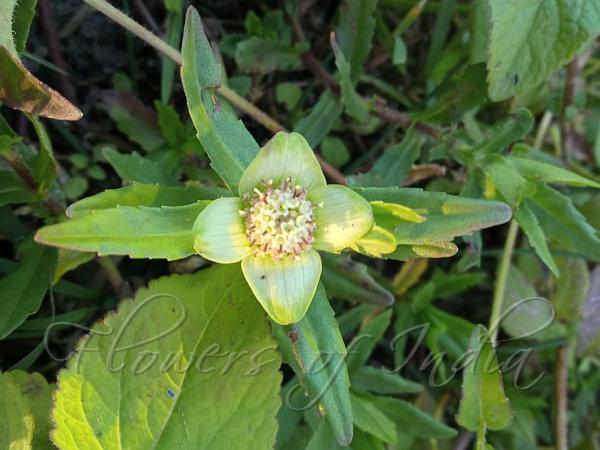|
| Buffalo Spinach |
|

|

|
|
|
|
Photo: |
Botanical name: Enydra fluctuans Family: Asteraceae (Sunflower family)
Synonyms: Enydra anagallis, Enydra hingcha,
Synonyms: Enydra anagallis, Enydra hingcha,
Buffalo Spinach is a perennial herb of swampy ground,
with stems stout, cylindric, hairy, slightly fleshy, prostrate in lower part,
50-80 cm. Leaves are nearly stalkless, oblong or linear-oblong, 2-6 cm
x 4-14 mm, finely gland-dotted on both surfaces, base stem-clasping, margin sparsely
sawtoothed, tip blunt or pointed. Flower-heads are 0.8-1.0 cm across,
with 4 prominent ovate-oblong bracts just below, 1.0-1.1 cm, tip
rounded. Receptacle is about 3 mm in diameter; paleae rigid, about 5
mm, tip toothed and sparsely velvet-hairy. Ray florets are about 3 mm,
blade 3- or 4-lobed in tip. Disk florets 5-lobed; stamens 5, rarely 6.
Achenes are obovoid-cylindric, about 3.5 mm. Buffalo Spinach is found
in marshes and streamsides, in the Himalayan foothills, China, SE Asia,
and Australia. Leaves are eaten as salad and also cooked in some places.
Flowering: November-April.
Medicinal uses: Decoction of the plant is used in urinal troubles, diarrhoea and dysentery.
Decoction of the plant is used in urinal troubles, diarrhoea and dysentery.
Medicinal uses:
 Decoction of the plant is used in urinal troubles, diarrhoea and dysentery.
Decoction of the plant is used in urinal troubles, diarrhoea and dysentery.
| Identification credit: Tabish | Photographed in Assam. |
• Is this flower misidentified? If yes,